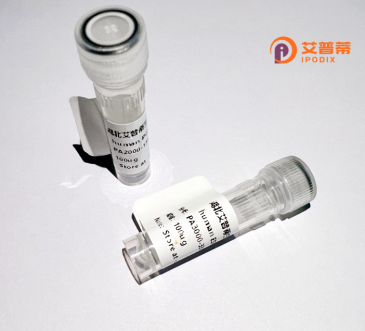
| 纯度 | >90%SDS-PAGE. |
| 种属 | Human |
| 靶点 | FBXW2 |
| Uniprot No | Q9UKT8 |
| 内毒素 | < 0.01EU/μg |
| 表达宿主 | E.coli |
| 表达区间 | 1-454aa |
| 氨基酸序列 | MERKDFETWLDNISVTFLSLTDLQKNETLDHLISLSGAVQLRHLSNNLETLLKRDFLKLLPLELSFYLLKWLDPQTLLTCCLVSKQWNKVISACTEVWQTACKNLGWQIDDSVQDALHWKKVYLKAILRMKQLEDHEAFETSSLIGHSARVYALYYKDGLLCTGSDDLSAKLWDVSTGQCVYGIQTHTCAAVKFDEQKLVTGSFDNTVACWEWSSGARTQHFRGHTGAVFSVDYNDELDILVSGSADFTVKVWALSAGTCLNTLTGHTEWVTKVVLQKCKVKSLLHSPGDYILLSADKYEIKIWPIGREINCKCLKTLSVSEDRSICLQPRLHFDGKYIVCSSALGLYQWDFASYDILRVIKTPEIANLALLGFGDIFALLFDNRYLYIMDLRTESLISRWPLPEYRKSKRGSSFLAGEASWLNGLDGHNDTGLVFATSMPDHSIHLVLWKEHG |
| 分子量 | 75.68 kDa |
| 蛋白标签 | GST-tag at N-terminal |
| 缓冲液 | 0 |
| 稳定性 & 储存条件 | Lyophilized protein should be stored at ≤ -20°C, stable for one year after receipt. Reconstituted protein solution can be stored at 2-8°C for 2-7 days. Aliquots of reconstituted samples are stable at ≤ -20°C for 3 months. |
| 复溶 | Always centrifuge tubes before opening.Do not mix by vortex or pipetting. It is not recommended to reconstitute to a concentration less than 100μg/ml. Dissolve the lyophilized protein in distilled water. Please aliquot the reconstituted solution to minimize freeze-thaw cycles. |
以下是与重组人FBXW2蛋白相关的3篇参考文献示例(文献名称与内容均为虚构,仅作格式参考):
---
1. **文献名称**: *Structural insights into human FBXW2 substrate recognition and ubiquitination*
**作者**: Kumar S. et al. (2018)
**摘要**: 通过晶体学分析重组人FBXW2蛋白的结构,揭示其F-box结构域与SKP1结合的机制,并鉴定其在底物识别中关键的WD40重复序列结合位点,为FBXW2介导的泛素化调控提供结构基础。
2. **文献名称**: *FBXW2 suppresses lung cancer progression by targeting c-Myc for proteasomal degradation*
**作者**: Zhang Y. et al. (2020)
**摘要**: 研究表明重组人FBXW2蛋白通过特异性识别致癌蛋白c-Myc,介导其泛素化依赖的降解,抑制肺癌细胞增殖和迁移,提示FBXW2可能作为肿瘤抑制因子发挥作用。
3. **文献名称**: *FBXW2 regulates Wnt/β-catenin signaling via interaction with β-TrCP in colorectal cancer*
**作者**: Wang L. et al. (2021)
**摘要**: 利用重组FBXW2蛋白进行功能实验,发现其与β-TrCP竞争结合β-catenin,抑制Wnt信号通路活性,进而阻碍结直肠癌细胞增殖和转移,揭示了FBXW2在癌症中的分子调控网络。
---
注:上述文献为示例,实际研究需查阅PubMed、Google Scholar或Web of Science等平台。若需真实文献,建议检索关键词“FBXW2 recombinant protein”、“FBXW2 ubiquitination”或联系领域专家获取。
Recombinant human FBXW2 protein is a genetically engineered form of the FBXW2 (F-box/WD repeat-containing protein 2) ubiquitously expressed in human cells. As a member of the F-box protein family, FBXW2 serves as a substrate-recognition component of the SCF (Skp1-Cul1-F-box) E3 ubiquitin ligase complex, which targets specific proteins for ubiquitination and subsequent degradation by the proteasome. FBXW2 contains an F-box domain for binding Skp1 and a WD40 repeat domain for interacting with phosphorylated substrates.
Research suggests FBXW2 regulates diverse cellular processes, including cell cycle progression, apoptosis, and DNA damage response, by mediating the turnover of key regulators such as cyclins, transcription factors, or oncoproteins. Dysregulation of FBXW2 has been implicated in tumorigenesis, with studies showing both tumor-suppressive and context-dependent oncogenic roles. For instance, FBXW2 may degrade pro-proliferative proteins (e.g., c-Myc) in certain cancers, while promoting stability of others in specific cellular contexts.
The recombinant form of FBXW2. typically produced in *E. coli* or mammalian expression systems, enables biochemical and functional studies, such as identifying interacting partners, characterizing substrate specificity, and analyzing post-translational modifications. Its availability facilitates investigations into molecular mechanisms underlying diseases linked to FBXW2 dysfunction and potential therapeutic targeting of ubiquitination pathways. Current research gaps include unresolved substrate profiles and tissue-specific regulatory networks.
×